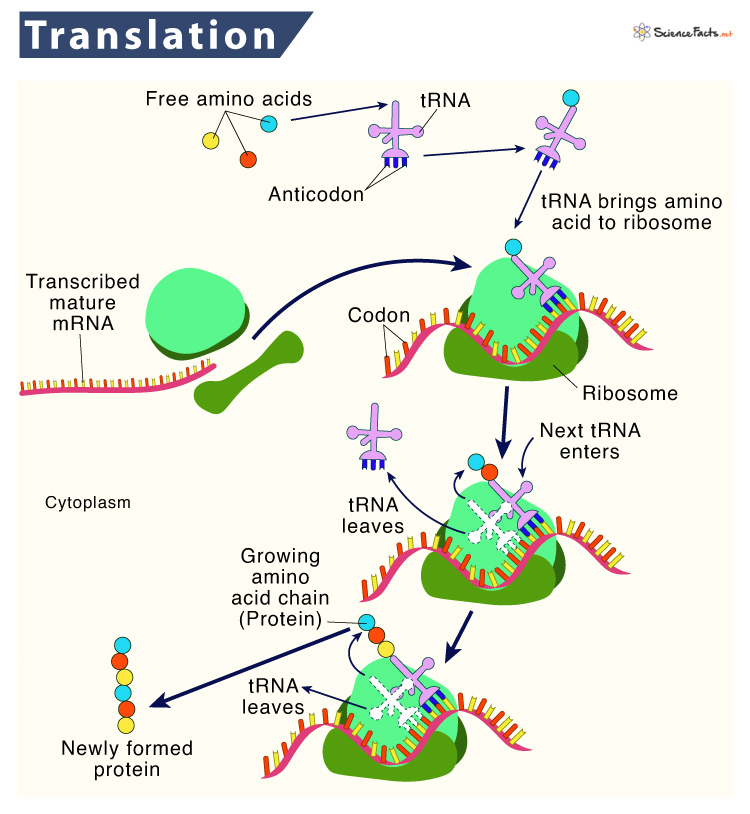Nevertheless, how are proteins made? Proteins synthesis occurs using the information in the DNA of a cell. The first step, called transcription, involves rewriting the information in DNA to mRNA. In contrast, the second step is called translation. Thus the main purpose of translation is to convert the information in mRNA into a particular sequence of amino acids (a polypeptide chain), forming a protein.
Where does Translation Occur in the Cell
Components of Translation
What is a Genetic Code in Translation
What Happens During Translation
What is the Fate of the Protein after Translation
2. Transfer RNA (tRNA)
In translation, the mRNA codons are read from 5’ to 3’ direction by a particular type of RNA molecule, the tRNA. Each tRNA carries an anticodon, a set of three nucleotides that binds to a particular mRNA codon by base pairing. On the other end, the tRNA carries the amino acid specific to the codon. There are many types of tRNAs. Each type reads one or a few codons and brings the right amino acid specific to those codons.
3. Ribosomes
Ribosomes are the structures where the polypeptides are synthesized. They consist of proteins and ribosomal RNA (rRNA). Each ribosome has two subunits, a large and a small subunit that come together like two halves of a hamburger brought together around a patty. When the two subunits bind, it forms three slots for binding the tRNA. These slots are named the A (aminoacyl), P (peptidyl), and E (exit) sites. Also, ribosomes act as an enzyme that catalyzes the chemical reaction that links amino acids to form a polypeptide chain.
4. rRNA
It is the structural component of the ribosome with three binding sites A, P, and E. One codon AUG, which codes for amino acid methionine, signals the start of translation. Similarly, there are three codons, UAA, UAG, and UGA, which signal the end of translation. This codon-amino acid relationship is called the genetic code as it codes an mRNA sequence whose product is a polypeptide chain. An amino acid attaches to its respective tRNA molecule through a covalent bond during initiation. The enzyme aminoacyl-tRNA synthetase mediates this bonding between the tRNA and the amino acid, methionine, forming met-tRNA. These charged tRNAs bring the amino acids to the ribosome in proper sequence, starting with methionine.
Initiation: The Beginning
In this step, the charged Met-tRNA binds to the smaller subunit of the ribosome. The tRNA then starts reading the mRNA from the 5’-3’ direction until it reaches the start codon, AUG. As soon as the tRNA finds a start codon, it binds to the P-site of the larger ribosomal subunit, forming the complete ribosome. This binding of Met-tRNA with the start codon forms the initiation complex that signals the beginning of the translation process. In bacteria, the situation is different. There the small ribosomal subunit attaches directly to a specific sequence in the mRNA. This sequence called the Shine-Dalgarno sequence lies just before the start codon. It marks the beginning of each coding sequence, letting the ribosome find the right start codon for each gene.
Elongation: The Extension
Immediately after the met-tRNA attaches to the P-site of the ribosome, another tRNA carrying the amino acid that matches the next mRNA codon comes and sits at the A-site of the ribosome. Then, the existing amino acid binds to the amino acid of the tRNA by a peptide bond. The methionine forms the N-terminus of the polypeptide, and the other amino acid is the C-terminus. Once bonded, the first tRNA leaves the ribosome through E-site, and the second tRNA shifts to the P-site, leaving the A-site vacant. The free tRNA again binds with another amino acid, and the elongation continues.
Termination: The End
It is the final translation step, where the polypeptide chain is released from the ribosomal complex. It occurs when either of the three stop codons UAG, UAA, or UGA in the mRNA triggers a series of events. Stop codons are recognized by proteins called release factors, which sit perfectly into the P site. It affects the enzyme activity by adding a water molecule instead of amino acid. This activity separates the polypeptide chain from the tRNA. What Happens to the Ribosome after Translation Once the translation is complete, the ribosomal complex dissociates, releasing the polypeptide chain into the cytoplasm as a newly formed protein. The subunits can again be reused during the next cycle of translation.
